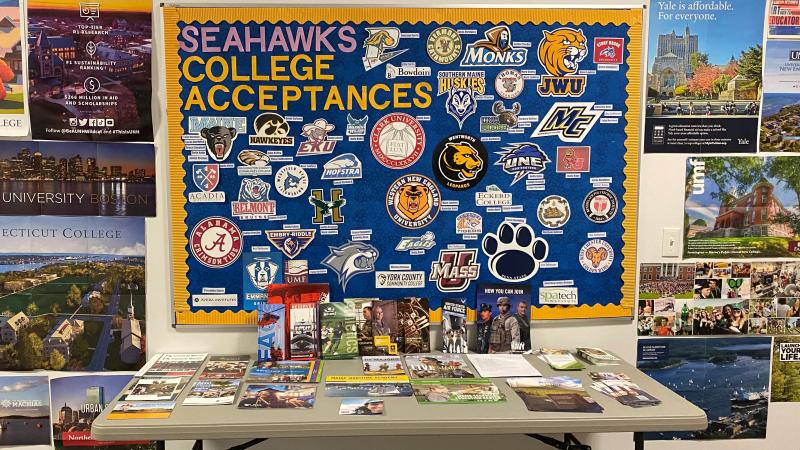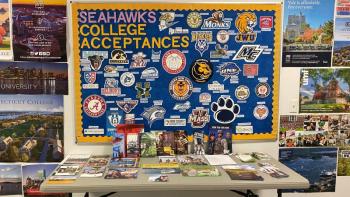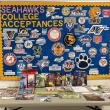Guidance office helps students navigate life after high school
Boothbay Region High School’s Class of 2022 will soon venture out into a world most adults are struggling to understand. Sophomores when the pandemic began in 2020, the 40 seniors are navigating the widely uncharted territory of post-secondary education and training where colleges and universities are struggling more than ever to attract students equally as uncertain about their futures.
College Access Coordinator Hannah Johnson said students, parents and teachers continue to feel overwhelmed with the stress of education in the pandemic. Adding the arduous Free Application for Federal Student Aid (FAFSA) process, portfolio and transcript organizing, test score submissions and everything else associated with applications, scholarships and financial aid, senior year for students and for their parents can become discouraging. While a normal year requires some perseverance for those looking toward college and university, Johnson said the Class of 2022 and all its support is coming through to ensure successful planning for “life after BRHS.”
The biggest change in college admissions since the start of the pandemic is greater emphasis on holistic review processes, said Johnson. While test scores like the SAT and grade point averages ruled the admissions process, schools are now looking more closely at admissions essays, extracurricular activities and projects, student recommendations and family responsibilities, she said. Guidance Counselor Leanne Burnham said with much more emphasis on who students are in and outside the classroom, students feel they have a better chance at getting into schools they might have considered beyond their reach.
“We are working really hard to make sure that all of the materials we are sending to support the students highlight all of those experiences and activities and no admission officers are saying, 'Huh, I wonder what that kid was really doing.' We want to fill in any gaps so there are no questions when they're reviewing it.”
In addition to FAFSA mobile apps and Maine-based outreach programs, another COVID-19 question was added to the Common App, said Johnson. The question provided a way to share the impact the pandemic had on things like grades, missing sports and absences in extracurricular activities. “Students have a lot to talk about from their 18 years on this planet, and many were worried that they'd have to use their essay … This helped ease the anxiety a bit for some. Few chose to use the space but just knowing it was there was enough.”
Traditionally selective schools have become even more selective, Johnson said. With admission rates as low as 5% for some schools, BRHS graduates are not just competing in a larger pool of students, they are also competing for scholarships and grants. Now, many students are making cost the driving factor in applying to schools and are considering community colleges when they previously might have not.
“We're really starting to see kids think about costs and whether or not to leave the state. That's a step in the right direction … A lot of students are also considering whether or not it's worth it to go to college. Many of my one-on-one sessions with students and parents are focused on what's the bottom line, can I make a decent wage if I go to a workforce training opportunity or an apprenticeship program. I'm seeing a lot of new programs pop up and students are expressing interest in those and are meeting with not just college reps, but people from different industries … We're trying to expose these students to more than just college.”
Johnson said the guidance office has been trying hard to make sure every pathway is valued equally and every student gets a fair shot at aligning themselves with any post-secondary opportunity. Students can attend the Maine C3 Virtual Career Fair March 23, an all day event which allows students 30-minute career information sessions, said Johnson. It encourages students to think outside the box about careers or pathways and creates a more transparent experience for them, she said.
Some students are looking at gap year programs and some juniors beginning the college exploration process are also looking at high school abroad programs. Many military programs for high-demand careers are offering as much as $20,000 in incentives to recruit high school graduates and several students are talking to recruiters, said Johnson. “I'm always telling them we all have a future, we can't avoid it, so we might as well plan for it.”
Said Burnham, “We have an opportunity with a class of 40 to personalize the process whether they're going to the workforce, they're interested in military, they're going to community college, going into an apprenticeship or applying to Harvard. We want to help every single one of those students to achieve whatever their goal is.”

























